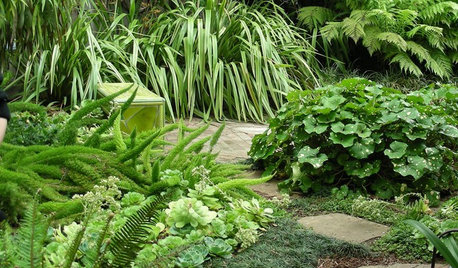Shade
gringojay
14 years ago
Related Stories

WINDOW TREATMENTSRoller Shades Raise the Curtain on Style
The humble window treatment is stealing the scene with fresh patterns, color and pizzazz
Full Story
WINDOW TREATMENTSHow to Choose the Right Window Shades
Should you roll with rollers or do as the Romans do? This mini guide to choosing window shades can help
Full Story
WINDOW TREATMENTSWhat’s the Right Way to Hang Roller Shades?
Over or under? It depends on how you want your shades to look, how much light you want to block and other factors
Full Story
Woven Wood Shades Tie Rooms Together
Contrasting sharp modern edges or complementing a contemporary look, these window shades are a lovely finishing touch for any room
Full Story
LANDSCAPE DESIGNHow to Create a Beautiful Shade Garden
Turn the cool, shady spot in your garden into your own quiet oasis
Full Story
LANDSCAPE DESIGNFind Yourself in an Epic Garden in the Shade
Feeling hot and tired gardening in the sun? The world of shade gardening beckons you to its cool mystery
Full Story
MOST POPULAR50 Shades of Gray
Gray is hotter than ever, thanks to a hit novel full of risks and dark secrets. Tell us: Which paint shade possesses you?
Full Story
PLANTING IDEAS8 Sumptuous Shade Garden Plant Combinations
Enjoy these plant combinations made for spots with varying levels of shade and different garden zones
Full Story
DECORATING GUIDESRoman Shades: The Just-Right Window Coverings for Summer
Calm and minimal, frilly or faux, There's a Roman shade for you
Full StoryMore Discussions








grizzman
gringojayOriginal Author
Related Professionals
Havre de Grace Landscape Architects & Landscape Designers · Battle Ground Landscape Contractors · Bedford Landscape Contractors · Dunwoody Landscape Contractors · Eureka Landscape Contractors · Holtsville Landscape Contractors · Laguna Hills Landscape Contractors · Pleasant Hill Landscape Contractors · St. Louis Landscape Contractors · Waldorf Landscape Contractors · Reisterstown Landscape Contractors · Crowley Landscape Contractors · Golden Valley Landscape Contractors · Quartz Hill Landscape Contractors · Norridge Landscape Contractorsjoe.jr317
joe.jr317
gringojayOriginal Author
joe.jr317
gringojayOriginal Author
gringojayOriginal Author